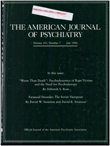A comparison of two iatrogenic dyskinesias
Abstract
The authors compared the regions of motor involvement in levodopa- induced dyskinesia and neuroleptic-induced tardive dyskinesia. Significantly more patients with tardive dyskinesia than parkinsonian patients with levodopa-induced dyskinesia had lip and tongue movements. Patients with tardive dyskinesia had significantly higher mean AIMS scores in the orofacial region than parkinsonian patients with levodopa- induced dyskinesia. More patients with levodopa-induced dyskinesia than those with tardive dyskinesia demonstrated hyperkinesia in the lower extremities. Limb and truncal movements in levodopa-induced dyskinesia were worse in patients with more severe parkinsonism and correlated positively with the length of Parkinson's disease. These findings suggest that these dyskinesias may involve different pathophysiological mechanisms.
Access content
To read the fulltext, please use one of the options below to sign in or purchase access.- Personal login
- Institutional Login
- Sign in via OpenAthens
- Register for access
-
Please login/register if you wish to pair your device and check access availability.
Not a subscriber?
PsychiatryOnline subscription options offer access to the DSM-5 library, books, journals, CME, and patient resources. This all-in-one virtual library provides psychiatrists and mental health professionals with key resources for diagnosis, treatment, research, and professional development.
Need more help? PsychiatryOnline Customer Service may be reached by emailing [email protected] or by calling 800-368-5777 (in the U.S.) or 703-907-7322 (outside the U.S.).



